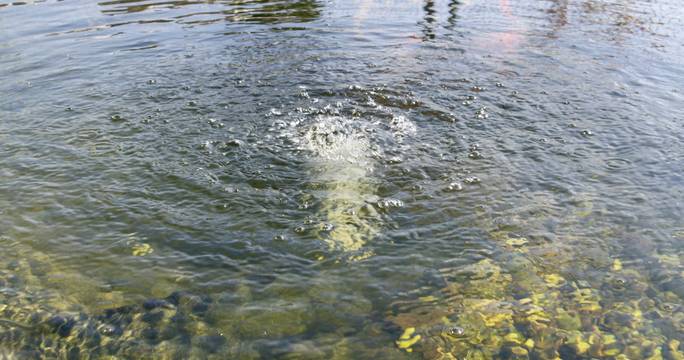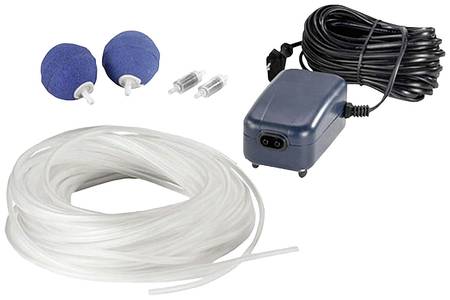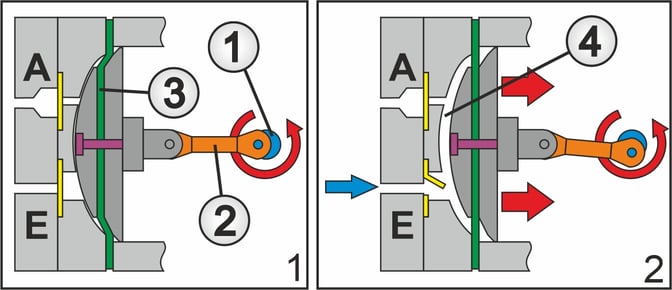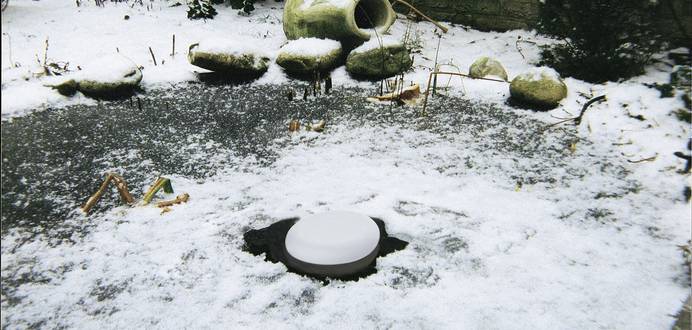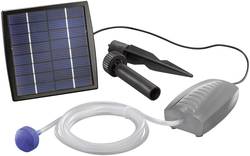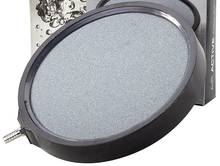Pond aerator » A breath of fresh air in your garden pond
Published: 12.08.2021 | Reading time: 8 minutes
This text is machine translated.
A beautiful pond in the garden looks inviting and is the pride of many people. After all, a lot of love, work and money goes into a well-kept garden pond. Especially when it contains beautiful, large and valuable fish.
On the other hand, lovingly created ponds also offer a very high recreational value. Many responsible people in a wide variety of companies have also recognized this. With a well-kept pond on the company premises, employees have a local recreation area for their lunch break, so to speak.
To ensure that this is the case in the long term, it is essential to keep an eye on the biological balance of the pond. Particularly in the hot summer months, the oxygen content in the water can quickly become too low as water temperatures rise. It is therefore an advantage if a pond aerator is available to provide immediate relief. In our guide, we explain how the technology works and the best way to aerate a pond.
In order for flora and fauna to survive in water, oxygen (O2) is naturally bound in the water.
This oxygen is absorbed by the water directly from the air or produced by aquatic plants through photosynthesis.
However, the maximum possible oxygen content of the water is highly dependent on the temperature. At a water temperature of 0 °C, the saturation value is 14.6 milligrams per liter (mg/l). If the water temperature rises to 20 °C, the saturation value is only 9.1 mg/l.
For a garden pond with fish, an oxygen concentration of 8 mg/l (at 20 °C) is considered the limit value. If the oxygen content is higher, the koi and all the other fish will have sufficient oxygen available. If the actual oxygen content is lower, this can lead to problems. The fish then come to the surface of the water and gasp for additional oxygen.
From a value of 3 mg/l, a critical value is reached at which the fish are harmed. The oxygen content of the pond water should therefore be checked regularly using suitable oxygen meters and the pond water aerated if necessary.
The easiest way to increase the oxygen content in the water is to blow air into the water using an electric air pump. This is because the oxygen content in the air we breathe is around 21%.
An electrically operated air pump draws in the ambient air, compresses it and feeds it into the water via a hose. Diffusers are used to ensure that the compressed air is finely distributed in the water.
Instead of a few large air bubbles, many small air bubbles are created. As a result, the air and water are optimally mixed and the oxygen in the air can be more easily absorbed by the water.
If an air distributor is used, diffusers can be placed at several points in the pond and supplied by a single pump.
Diaphragm pumps are preferably used as electric pumps. In contrast to piston pumps or compressors, which can supply a larger volume of air, diaphragm pumps are more compact, quieter and also cheaper.
A small electric motor causes a diaphragm (3) to vibrate via an eccentric (1) and a linkage (2) (see Figure 1). This increases or decreases the volume of the air chamber (4) in the head cover. Depending on the direction of movement of the diaphragm, this creates either negative or positive pressure in the air chamber.
When the chamber volume is increased, the negative pressure causes air to flow into the air chamber from outside via the inlet valve (E) (see Figure 2). At the same time, the outlet valve (A) is pressed tightly shut by the higher external pressure. When the diaphragm has reached the position with the largest air chamber volume, the inlet valve closes automatically (see Figure 3).
If the volume decreases again, the increasing pressure presses the air outwards via the outlet valve (see Figure 4). At the same time, the inlet valve is pressed tightly closed. For a better overview, the hose or hose connection at the outlet is not shown. When the air chamber has the lowest volume and no more air is flowing through the outlet valve, the outlet valve closes automatically (see Figure 1). The cycle can now start again.
Aeration is always necessary if there is a risk that there is too little oxygen in the water for the fish. Therefore, a garden pond without fish does not necessarily need to be aerated. But even if fish are present, aeration is not necessarily or permanently required. If there are few fish and a sufficient number of oxygen-producing plants, there is no need to introduce additional oxygen into the water. Water features, fountains and streams also naturally increase the oxygen content in the water.
In winter, however, when aquatic plants do not produce oxygen and fountains and streams are switched off, aeration makes perfect sense.
This is because in addition to enriching the water with oxygen, the putrefactive gases are also expelled at the same time. However, this requires that the ice cover on the garden pond is not completely closed. This is why some manufacturers have developed pond aerators that also work as ice-free holders.
Another advantage of pond aerators is that they support the filter bacteria required for biological purification. This is because these bacteria need plenty of oxygen to convert toxic ammonia and nitrite into harmless nitrate.
To help you find the best aeration system for your pond, we have put together some important decision criteria:
Delivery rate in liters per hour
In order to keep the subsequent operating costs as low as possible, the aeration system should not be oversized. Because a lot helps a lot is unfortunately not true in this case due to the maximum possible oxygen saturation of the water.
As a rule of thumb, the air pump should have a maximum flow rate per hour that corresponds to approx. 1/5 of the pond volume. A pond pump that delivers an air volume of 900 l/h would be perfectly suitable for a pond with a volume of approx. 4500 l.
Power supply
Most aeration pumps require a 230 V mains connection. Especially if they are powerful air pumps.
Alternatively, there are also aeration systems that are supplied with power via a solar panel. However, these pumps have a rather low output and only work when the sun is shining.
Air outlet
For large ponds, it is better to integrate a distributor into the air hose and thus place several diffusers in different places and at different water depths.
Please note that the deeper the diffuser is positioned, the higher the back pressure of the water and the lower the amount of air flowing out. Air diffusers are available in different designs (stones or plates) and made of different materials.
Our practical tip: Where to install the aerator pump
As pond technology should ideally be installed out of sight, it is very tempting to place the aerator pump in a shaft outside the pond. However, as soon as the installation location of the pump is lower than the water level, there is a risk that water will flow through the air hose to the pump when the pump is switched off. This will destroy the pump. It is better to set up the aerator pump so that the installation location is above the water level. If this is not possible, a non-return valve in the air line can prevent the water from flowing back to the pump.
How deep should the outlet of a pond aeration system be installed?
In order for the pond aeration system to work effectively, the back pressure of the water must not be too high. Otherwise the amount of air flowing out would be reduced. However, even if the pond aerator generates sufficient pressure, it is not always ideal to place the aerator at the lowest point of the pond. This is because pond aeration also creates a current within the water layers, which is particularly unfavorable in winter when the fish are resting at the bottom.
Why can pond aeration cause the water to become cloudy?
The rising air bubbles also ensure increased movement within the water layers. This stirs up sediment and suspended particles from the bottom of the pond and can cloud the water. With a well-functioning and regularly maintained filter system, the clouding should disappear by itself after a few days due to the pond aeration.
What are the advantages of a pond aerator set?
If you use a pond aerator set with a wide range of accessories for pond aeration, you can be sure that the individual components fit together perfectly. If you buy them individually, there is a risk that the air hose, for example, may be too small in diameter or too long. Even if the pond aerator is sufficiently dimensioned, the pond aeration system will not work effectively if the hose is not suitable.
Can I control a pond aerator via a timer?
Yes, that is possible. For example, the water could be supplied with additional oxygen at night when the aquatic plants are not photosynthesizing. This compensates for the day/night fluctuation of the oxygen content in the water. However, it must be ensured that no water can flow through the air hose to the pump when the system is switched off.
What are the advantages of solar pond aerators?
Basically, the air or oxygen pump in a solar pond aerator only works when the sun is shining on the solar module. Solar pond aerators are therefore unsuitable for a pond where the aerator has to work constantly. However, if the pond has a good basic supply of oxygen due to aquatic plants, fountains or a stream, a solar-powered pond aerator will easily cover the peak demand. This is because when the water temperature in the pond rises due to solar radiation and the oxygen saturation decreases as a result, the solar pond aerator supplies sufficient oxygen.
What is an oxygen pump for pond aeration?
When we talk about an oxygen pump for pond aeration, this is not technically correct. This is because the pump in the aerator is more of an air pump that blows oxygen into the water as part of the air.
